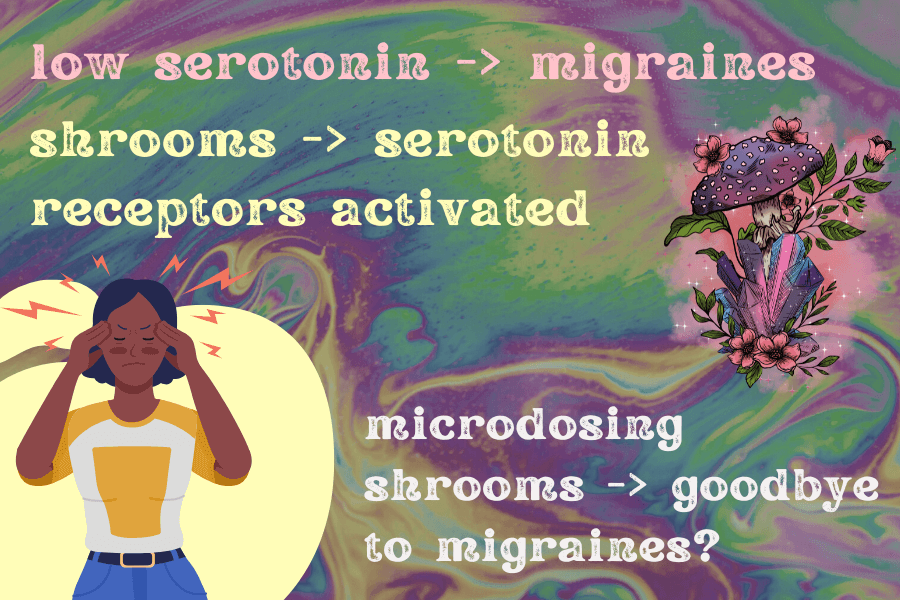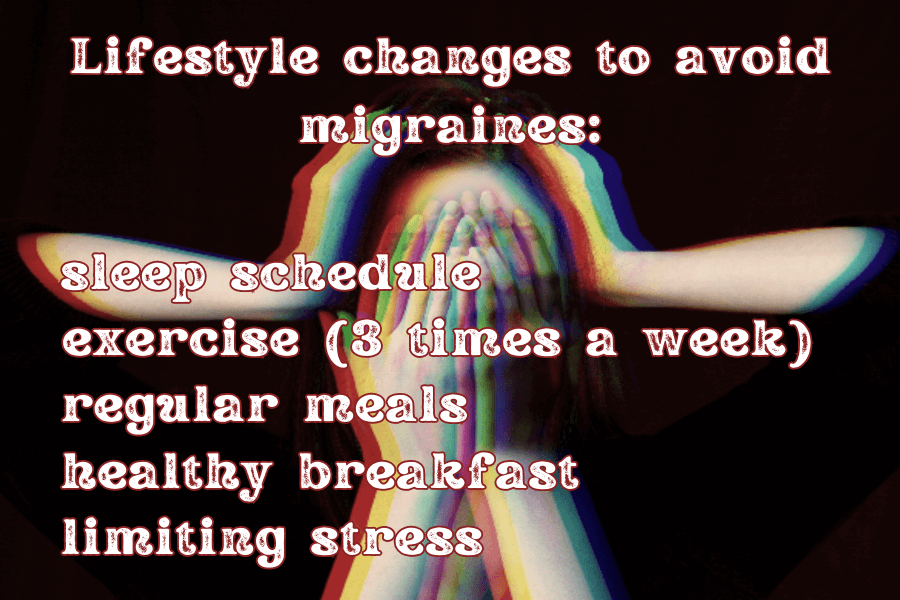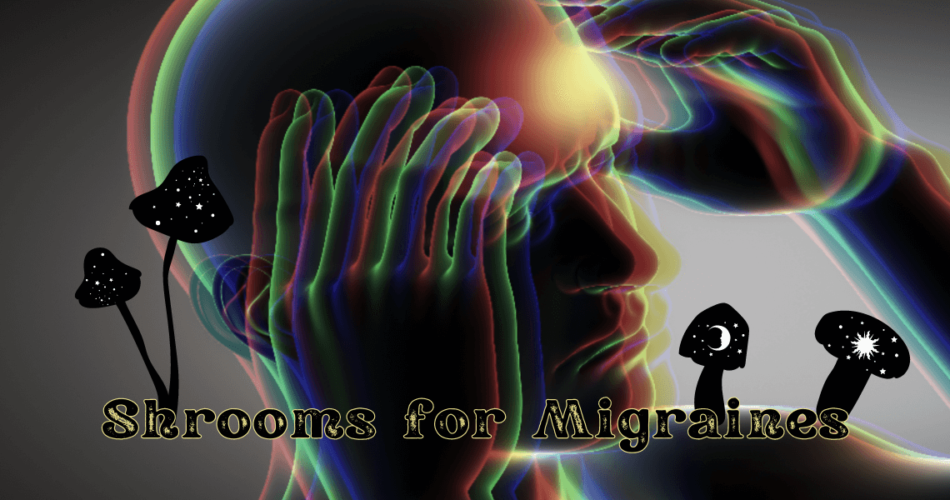How to microdose mushrooms for migraines? Psilocybin, their active compound, has been found to help relieve migraine pain and other symptoms. Let’s discuss how to go about using this natural remedy.
TL;DR
- Microdosing for headaches starts with sourcing high-quality shrooms and preparing capsules 🍄
- The typical dose is 0.1 g to 0.5 g of dried mushrooms, taken 1–4 times a week with breaks in between 🍄
- Keeping a headache journal is recommended to see if the microdosing works or not 📝
What Do Mushrooms Have to Do With Migraines?
Migraines, a neurological disorder characterized by intense and throbbing headaches, affect millions of people worldwide. Typical treatment for migraine and cluster headaches involves prescription meds such as triptans, beta-blockers, and antidepressants. However, more and more sufferers are finding relief in alternative medicine – specifically, microdosing psilocybin mushrooms.

A low dose of psilocybin may not produce psychedelic effects but have therapeutic potential. Recently, mushrooms have garnered attention for their potential to alleviate migraine headaches. Psilocybin has the ability to affect serotonin levels in the brain, and low levels of serotonin are believed to contribute to migraine formation.
This article will provide a comprehensive guide on how to microdose psilocybin mushrooms for migraines safely and effectively. Note that the use of psilocybin mushrooms is illegal in many countries, and this guide is for informational purposes only.
Promising Study 🔍
In 2021, a study by Emmanuelle A. D. Schindler was published in the Neurotherapeutics journal about how psilocybin suppresses migraines. In the study, 10 patients who often suffered from migraines took a placebo capsule, followed by a psilocybin capsule 2 weeks later. Starting 2 weeks before the placebo, they kept a headache diary until 2 weeks after taking psilocybin. The result was that psilocybin reduced pain severity and migraine-related functional impairments significantly better than the placebo.
What Is Microdosing?
Microdosing involves the consumption of minuscule amounts of psychedelic substances, typically between 1/10th and 1/20th of a standard recreational dose. The objective is not to experience the psychedelic effects of psilocybin but instead to make subtle changes in mood, cognition, and health.
How to Microdose Mushrooms for Migraines, Then?
Before starting a microdosing regimen to manage migraines, it’s essential to source high-quality and accurately identified psilocybin mushrooms. Ideally, a mycologist’s guidance is recommended. Alternatively, spores or mycelium can be purchased legally in certain jurisdictions to grow mushrooms at home. Now, how to microdose mushrooms for migraine headaches?

Step 1: Determine a Suitable Dosage
The appropriate microdose varies between individuals, and it’s crucial to start with a low dose and gradually increase it until the desired effect is achieved. Typically, a microdose ranges from 0.1 to 0.5 grams of dried psilocybin mushrooms. The desired effect should be relief from headache disorders without any significant alterations in perception or cognition.
Step 2: Create a Microdosing Schedule
An effective microdosing schedule generally involves taking the chosen dose once every 2–3 days. A typical plan may be to microdose on a Monday, take a break on Tuesday and Wednesday, and then again on Thursday. This allows the body and brain to reset and avoid building a tolerance to the effects of the psilocybin.
Step 3: Find a Suitable Consumption Method
One method is to grind dried mushrooms into a fine powder and encapsulate them using empty gelatin capsules. This provides a consistent and discreet method of consumption. Alternatively, the powder can be mixed into food or drink, but the user needs to be careful not to exceed the single dose.
Step 4: Record Responses in a Diary and Adjust Accordingly
It’s essential to keep a journal of the microdosing experience, noting any changes in mood, migraine symptoms, and overall well-being. If no benefits are observed, the user should consider adjusting the dosage within the recommended range. They should also discontinue microdosing if any serious adverse effects emerge or if the migraines don’t improve after several weeks.
Potential Risks and Legal Considerations
Knowing how to microdose mushrooms for migraines, you also need to be aware of the risks. Some potential side effects include:
- increased heart rate;
- increased blood pressure; and
- anxiety.
Importantly, psilocybin mushrooms and their active compounds are illegal in many countries, and this guide is for informational purposes only. It’s also difficult to say whether psilocybin treats headaches more effectively than a placebo. Only preliminary studies have been done so far. Professors from various schools of medicine warn that taking drugs is never fully safe.
Conclusion: Low Psilocybin Doses Can Alleviate Migraines
If you were interested in how to microdose mushrooms for migraines, now you know the basics. Remember to consult a healthcare professional before considering any alternative treatment options and to adhere to the laws in your jurisdiction. Sometimes, preventive measures such as watching your diet and keeping a consistent sleep schedule are enough to reduce the frequency of headaches.

Frequently Asked Questions
Can Psilocybin Reduce Migraine Headaches?
Yes, psilocybin has been found to reduce migraine headaches in some patients. It also works for cluster headaches, which are even harder to treat in traditional ways.
Is Psilocybin Safe to Take for Migraine Headaches?
Yes, when taken in the recommended dosage, psilocybin is generally safe for migraine sufferers. However, consulting with a doctor beforehand is a must.
Are There Any Side Effects of Taking Psilocybin for Migraine Headaches?
Some people have reported feeling lightheaded or dizzy after taking psilocybin. This isn’t something that migraine sufferers would want to experience.
How Long Does It Take for Psilocybin to Work for Migraine Headaches?
Generally, migraine relief can be felt within a few hours of taking psilocybin. The therapeutic effect can last for weeks, even after a single dose. Keep in mind that in healthy people, psilocybin can cause headaches rather than relieve them.
Similar Posts:
- Headache After Shrooms: Trip Recovery After Psychedelic Magic Mushrooms
- Is LSD Good for You? Benefits of Microdosing and Other Uses of LSD
- Microdosing Shrooms. What Does It Mean? Find out More About Psilocybin and Psychedelic Effects of Magic Mushrooms
- Discovering Shrooms for Anxiety. A Comprehensive Guide to Magical Mushrooms and Depression
- Redosing Shrooms: How Does Repeating the Dose of Magic Mushrooms Work?
- How Much Shrooms Should I Take? Magic Mushroom Dosages, Microdosing Psilocybin, Heroic Dose
- Shrooms Dosage. How Much of Magic Mushrooms Is Enough? How Much of Psilocybin Can Lead to Overdose?





